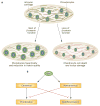To Wnt or not to Wnt: the bone and joint health dilemma
- PMID: 23459013
- PMCID: PMC4830431
- DOI: 10.1038/nrrheum.2013.25
To Wnt or not to Wnt: the bone and joint health dilemma
Abstract
The Wnt signalling cascades have essential roles in development, growth and homeostasis of joints and the skeleton. Progress in basic research, particularly relating to our understanding of intracellular signalling cascades and fine regulation of receptor activation in the extracellular space, has provided novel insights into the roles of Wnt signalling in chronic arthritis. Cartilage and bone homeostasis require finely tuned Wnt signalling; both activation and suppression of the Wnt-β-catenin cascade can lead to osteoarthritis in rodent models. Genetic associations with the Wnt antagonist encoded by FRZB and the transcriptional regulator encoded by Dot1l with osteoarthritis further corroborate the essential part played by Wnts in the joint. In rheumatoid arthritis, inhibition of Wnt signalling has a role in the persistence of bone erosions, whereas Wnts have been associated with the ankylosing phenotype in spondyloarthritis. Together, these observations identify the Wnt pathway as an attractive target for therapeutic intervention; however, the complexity of the Wnt signalling cascades and the potential secondary effects of drug interventions targeting them highlight the need for further research and suggest that our understanding of this exciting pathway is still in its infancy.
Conflict of interest statement
The authors declare no competing interests.
Figures




References
-
- Clevers H, Nusse R. Wnt/β-catenin signaling disease. Cell. 2012;149:1192–1205. - PubMed
-
- Kadowaki T, Wilder E, Klingensmith J, Zachary K, Perrimon N. The segment polarity gene porcupine encodes a putative multitransmembrane protein involved in Wingless processing. Genes Dev. 1996;10:3116–3128. - PubMed
-
- Bänziger C, et al. Wntless, a conserved membrane protein dedicated to the secretion of Wnt proteins from signaling cells. Cell. 2006;125:509–522. - PubMed
-
- Tabata T, Takei Y. Morphogens their identification and regulation. Development. 2004;131:703–712. - PubMed
-
- Mii Y, Taira M. Secreted Frizzled-related proteins enhance the diffusion of Wnt ligands and expand their signalling range. Development. 2009;136:4083–4088. - PubMed
Publication types
MeSH terms
Substances
Grants and funding
LinkOut - more resources
Full Text Sources
Other Literature Sources
Medical

